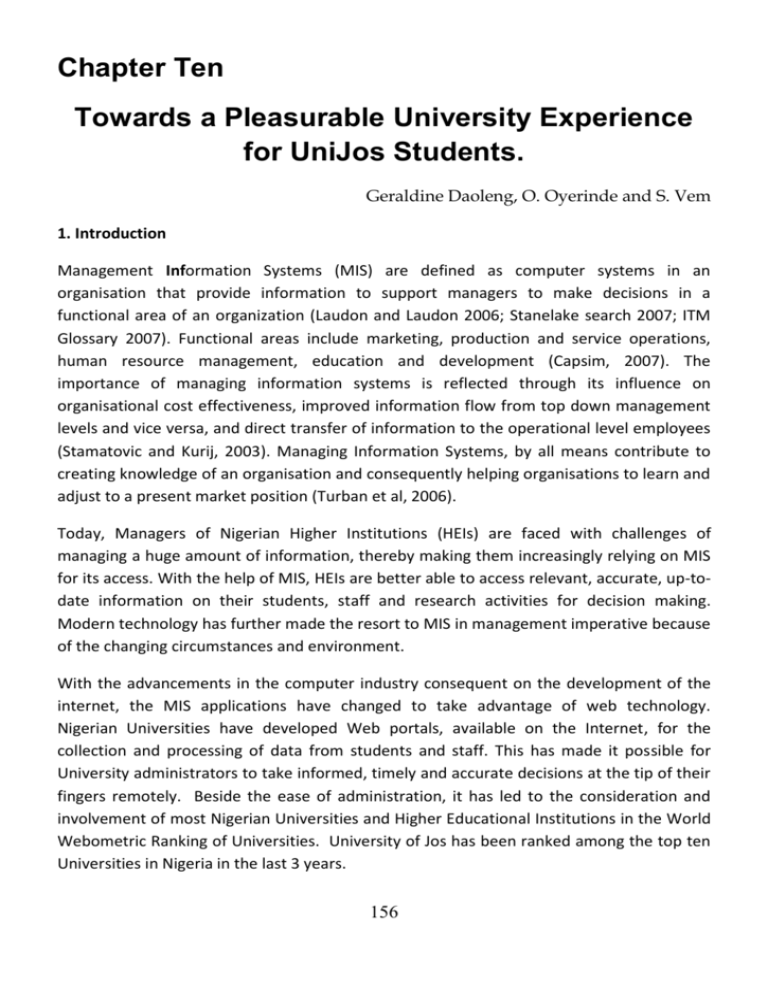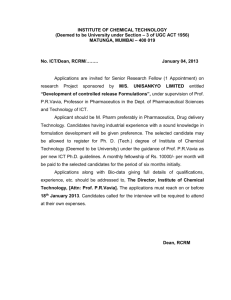
Chapter Ten
Towards a Pleasurable University Experience
for UniJos Students.
Geraldine Daoleng, O. Oyerinde and S. Vem
1. Introduction
Management Information Systems (MIS) are defined as computer systems in an
organisation that provide information to support managers to make decisions in a
functional area of an organization (Laudon and Laudon 2006; Stanelake search 2007; ITM
Glossary 2007). Functional areas include marketing, production and service operations,
human resource management, education and development (Capsim, 2007). The
importance of managing information systems is reflected through its influence on
organisational cost effectiveness, improved information flow from top down management
levels and vice versa, and direct transfer of information to the operational level employees
(Stamatovic and Kurij, 2003). Managing Information Systems, by all means contribute to
creating knowledge of an organisation and consequently helping organisations to learn and
adjust to a present market position (Turban et al, 2006).
Today, Managers of Nigerian Higher Institutions (HEIs) are faced with challenges of
managing a huge amount of information, thereby making them increasingly relying on MIS
for its access. With the help of MIS, HEIs are better able to access relevant, accurate, up-todate information on their students, staff and research activities for decision making.
Modern technology has further made the resort to MIS in management imperative because
of the changing circumstances and environment.
With the advancements in the computer industry consequent on the development of the
internet, the MIS applications have changed to take advantage of web technology.
Nigerian Universities have developed Web portals, available on the Internet, for the
collection and processing of data from students and staff. This has made it possible for
University administrators to take informed, timely and accurate decisions at the tip of their
fingers remotely. Beside the ease of administration, it has led to the consideration and
involvement of most Nigerian Universities and Higher Educational Institutions in the World
Webometric Ranking of Universities. University of Jos has been ranked among the top ten
Universities in Nigeria in the last 3 years.
156
2. ICT Support From Freshman Registration to Graduate Transcript
2.1: Preamble: The evolution of Management Information System (MIS) in the Nigerian
Educational System started in the late 1980's. This idea was conceptualized by the National
University Commission (NUC) in partnership with the British Council. In 1992, the
University of Jos joined the ranks of four other Universities to pilot the establishment of a
Nigerian University Management Information System (NUMIS) managed by the NUC. About
10 years later, this NUMIS project was abandoned by the NUC due to bureaucracy,
communication difficulties and other related challenges.
In spite of the abandonment of NUMIS by the NUC, UniJos continued to invest in an MIS
initiative locally. We did so by recruiting and training programmers, purchasing equipment
as well as partnering with industry and other Higher Education Institutions (HEIs) within
and outside the country. The singular effort of the University was recognized by the NUC
with an award in 1999 as the best rated in digitization efforts in the Nigerian University
System
The University of Jos Management Information System (UJMIS) has adopted different
development platforms, at different times. In 1992, dBase III was first used as the database
engine. We have since transitioned, in several phases, through MS Access, MS SQL to
MYSQL which is currently in use. The choice of MYSQL was made in 2005 in line with the
policy of the ICT Committee led by Professor L. S. O. Liverpool. We did so to encourage the
use of Free and Open Source Software (FOSS) as the University application development
tool. This was in view of its stability and cost effectiveness for an educational institution
with lean resources. Today MIS is an integral part of an ICT Directorate and in line with an
enlarged agenda, goes by the name of Corporate Information Systems (CIS).m
The University of Jos leads other HEIs, as the first Nigerian University to develop an inhouse Students Information System (SIS) portal using FOSS development tools. Several HEIs
have learnt from our experience, through technical visits, short term residence of techies
and exchange of documentation. Since 2005, the University has progressively used the
portal for the enrolment of all categories of students. Provisions for undergraduate
interaction with the system spans from Post University Matriculation Examination screening
to bio-data record-capturing, clearances, payment of fees, allocation of hostel
accommodation, course registration, result capturing to transcript processing. A separate
digital transcript processing application funded by the Jos Carnegie Partnership has been
developed and is in use for the retro-conversion of the legacy students’ results. Results of
over 44,000 graduates that completed their studies in the last ten years have been captured
157
and are at various stages of processing. The SIS application is also in use by diploma,
remedial and postgraduate students who can interact with the system from sales of forms
to course registration.
The huge successes recorded in the digitization of students’ records at the University can
be attributed to the continued commitment of successive university leaderships. Generous
provisions of human and material resources continue to be made, to this pursuit since the
1990's, despite strong competition, from many quarters, for lean resources. These efforts
of the University have been strengthened by the inputs of the Jos Carnegie Partnership
grant. The bulk of the grant was sunk into ICT development for the 3 tranches spanning
over a period of about ten years. The grant revolutionized the university digitization
agenda leading to the launching of the first on line University SIS. The SIS is one example of
how UniJos is using ICT to make the experience of our students in university, a pleasurable
one. In the rest of this chapter we provide and discuss some procedures involved in using
the University of Jos SIS.
2.2 Registration procedure: The prospective student commences interaction with the
system from the release of the admissions list, to course registration and fee payment. All
categories of students use the application across all levels. Below we highlight the basic
functions of the SIS application in the life of a student from freshman registration to
graduation.
(i)
Candidates for admission check their admission status online. Successful
candidates then proceed to make acceptance payments online using the
online card payment application.
158
Figure 39: Sceen Capture of Admission Web Page
(ii)
Upon successful payment of acceptance fees, the students proceed to do
bio-data registration online. This is the main registration where all
necessary information about the students, as required by the University, is
collected. Their passports and signatures are collected as well for other
purposes including ID card issuance.
Figure 40: Screen Capture of SIF
(iii)
Upon completion of the Bio-Data registration, the students proceed to
Academic office and Faculty clearance. Here the Clearance officers sight
159
the originals of the candidates’ credentials and effect the clearances online.
Those who do not meet admission requirements are effectively screened
out at this stage. The system does not allow them to proceed further
except if change of course is approved.
Figure 41: Screen Capture of Academic Officer Page
(iv)
Successful Students then proceed to pay Approved School Charges using
our online card payment application. It is a licensed Interswitch application
where payments are made using credit/debit and/or ATM cards from banks
on the Interswitch platform.
Figure 42: School Charges Payment Scheme
(v)
Upon successful payment and printing of receipts, the students proceed to
departmental course registration. Here the list of courses available for their
160
level as recommended by the department is available for use to register.
After completion of the registration online, copies are printed for
departmental administrative purposes, as necessary.
Figure 43: Screen Capture of Student Page
(vi)
A robust Hostel Allocation application was developed for the Directorate of
Students Affairs to assist them in allocation of the Hostel Spaces. This is
available only for students who have completed registration and paid the
stipulated school charges.
(vii)
Using the information captured during the bio-data registration and
submissions in the duly completed medical forms, a student identity card is
printed for the students. The collection of the identity card marks the
completion of the Registration procedure for newly admitted students.
161
Figure 44: Screen Capture of ID Card
(viii)
In furtherance of the University's eLearning initiative, a Computer Based
Testing (CBT) application has been developed for Continuous Assessment
testing and Final Examinations. The General Studies Department
successfully used the application for all assessments and examinations for
the 2011/2012 academic session. Other departments such as physics, and
special education, are working towards the use the application for
semester assessments and examinations.
(ix)
Senate Approved Results are uploaded and put on the application for
students to view. It is the desire of the ICT directorate and management,
that this will form the data for sessional transcripts and ultimately final
transcripts as well as generation of graduands lists for convocation
purposes.
162
Figure 45: Screen Capture of Student Area
3. Benefits and challenges
The University has derived several benefits from the digitisation of the Students
Information System. We also have several challenges that we continue to address. The
main benefits and critical challenges are listed for completeness.
a) Increase in the efficiency of storage and retrieval of students’ information with
corresponding increase in productivity of staff.
b) Massive reduction in paper work and overhead costs, thereby making large savings
for the University.
c) A quicker, easier and more pleasurable registration process, for students and staff.
d) Improved transparency and accountability enshrined in the university system.
e) Introduction of new students to the use of Information Technology to support the
progressive building of an ICT culture for global competitiveness.
The successes recorded by UniJos in the last ten years were not without its challenges,
some of which include:
a) Inadequate provision of the basic underlining infrastructure such as power,
equipment; the slow growth of the university network, that has to sustain the
anticipated development.
b) Slow understanding and correct implementation of the users' requirements in an
in-house application development. UNCLEAR.
c) Difficulty in sustaining the rate of development and provision of support in view of
163
the dynamism in ICT.
Slow buy-in by users and policy-makers of the new system complemented by slow
pace of technical staff to keep abreast of development and maintenance of the
application.
d) Inadequate provision of the required IT Management skills and competence to
harness the potentials available for sustainable development.
e) Insufficient computer access for students and staff coupled with inadequate
knowledge and awareness by students for smooth operation of the system.
Despites the success and challenges, the ICT Directorate of the university remains fully
committed to support all other arms of the university to use ICT for the benefit of the
institution. We are confident that in this effort we shall move from strength to strength.
4. References and Bibliography
Capsim, (2007) www.capsim.com; Accessed 17 May 2007
ITM Glossary http://www.wiley.com/college/turban/glossary.html; Accessed 9 May 2007.
Laudon, K.C. and Laudon, J.P. (2006) Management Information Systems: Managing the
Digital Firm, Pearson Prentice Hall, Upper Saddle River, New Jersey.
Stamatović, M., Kurij, K. (2003), Introducion to Strategic Managemet, Savez in enjera i
tehni ara Srbije – Centar za razvoj, Belgrade.
Stanelake
glossary;
search,http://www.stanlake.co.uk/recruitment-candidates/recruitmentAccessed 9May 2007.
Turban,E., Leidner, D., McLean,E., Wetherbe, J (2006) Information Technology for
Management: Transforming Organizations in the Digital Economy, John Wiley & Sons
Australia, 2005.
164






